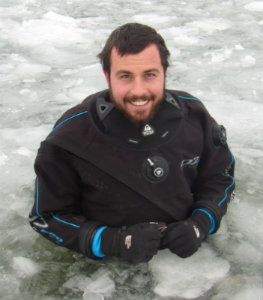Cellular Self-Destruction
A new study finds that humans and corals share a key biomechanical pathway that tells cells when to die.

We humans climb trees, compose operas, and send rockets to the far corners of the universe. Corals, on the other hand, just kind of sway there at the bottom of the sea. It’s hard to imagine a creature with seemingly less in common with humans, but a recent study by San Diego State University biologists has discovered that both species share a 500-million-year-old biomechanical pathway responsible for triggering cellular self-destruction. That might sound scary, but killing off defective cells is essential to keeping an organism healthy.
The finding will help biologists to advance their understanding of the early evolution of multicellular life, conservationists to better understand the plight of modern corals, and medical researchers to develop new drugs to fight diseases like cancer.
Steven Quistad, a graduate student working in the lab of SDSU virologist Forest Rohwer, made the discovery earlier this year somewhat by accident. Rohwer leads SDSU's Viral Information Institute, one of the university's Areas of Excellence. The cross-disciplinary institute explores interactions between viruses and the biosphere in order to improve human and environmental health.
Like Rohwer, Quistad has spent most of his research career so far studying viruses. While analyzing the proteins of the coral Acropora digitifera and matching them against human proteins, he found a peculiar similarity: Both had receptor proteins that receive signals from another protein called tumor necrosis factor, or TNF.

Orderly death
When TNF proteins attach themselves to a cell’s TNF receptors, the cell launches into an orderly self-destruct mode. The protein strands inside the cell break down and the cellular components are cordoned off and carried away to be recycled. The process, known as apoptosis, plays a crucial role in cellular health, allowing defective cells to destroy themselves before they can cause damage to the organism.
When Quistad looked more closely at the coral’s genome, he noticed that it had genes that coded for not just one TNF receptor, but 40 of them. TNF comes in many different “flavors,” and each one matches with a particular receptor. The coral Quistad investigated had 14 different flavors of TNF and more TNF receptors than any other known organism on the planet. Humans, by comparison, have 25 TNF receptors.
So what would happen if you took the human version of a TNF protein and exposed it to a coral’s TNF receptors? Quistad and his colleagues did just that and watched for the telltale signs of apoptosis. Under a microscope, they saw evidence that the coral cell was breaking down within 10 minutes of exposure to human TNF. A series of other cellular signals associated with apoptosis confirmed it: Human TNF sets into motion programmed cell death in corals.
Vice versa?
Next, Quistad and colleagues wondered if coral TNF proteins would trigger apoptosis in human cells. They coaxed E. coli bacteria to express the same TNF proteins produced by corals and exposed them to cultured human tissue. Sure enough, apoptosis occurred in the human cells. Quistad published these results today in the Proceedings of the National Academy of Sciences.
The findings suggest that the pathway by which TNF triggers apoptosis is old. Extremely old.
“The fact that it goes both ways means that these domains haven’t changed in half a billion years,” Quistad said. “Corals are actually much more similar to humans than we ever realized.”
That’s interesting from an evolutionary biology perspective, Quistad said, because approximately 542 million years ago, organized life took off in a very big way. Known as the Cambrian Explosion, this period saw the emergence of the early ancestors of much of the life that exists today, including humans. No one really knows what set off the Cambrian Explosion, but it’s possible the evolution of orderly, systematic cell death played a leading role.
“TNF-induced apoptosis could turn out to be one of the major sparks of the Cambrian Explosion,” Quistad said.
Coral conservation
Unfortunately, after half a billion years of success, corals today aren’t doing so well. The effects of climate change and ocean pollution are taking their toll on the atolls. A fatal stress response known as coral bleaching, whereby corals expel the bacteria that give them their vibrant colors, is decimating corals around the world. Previous studies have linked apoptosis to this process, and indeed, the corals to which Quistad exposed TNF eventually bleached out.
A better understanding of how TNF mediates apoptosis in coral might allow conservationists to identify more resilient species, and then reintroduce these hardier corals to places where coral loss is hurting the local ecosystem, Quistad said.
Preserving and learning from these corals is important for human health, too. Corals are wonderfully complex organisms, Quistad said, and we’re only beginning to learn their secrets.
“Many people look at a coral and think it’s just a slimy rock,” he said. “They think, ‘How can it be so complex at a molecular level when it looks so simple?’”
Quistad said that by studying corals’ various flavors of TNF proteins and TNF receptors, researchers might uncover medical properties useful for killing specific kinds of renegade cells, such as cancer cells.
“We have a lot to learn from corals about our own immune system,” he said.



